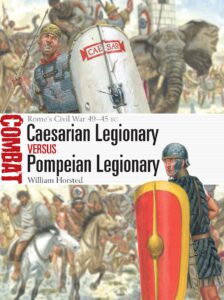William Horsted, Caesarian Legionary versus Pompeian Legionary (Osprey, 2025)
On a cold January day in 49 BCE, Julius Caesar ‘rolled the dice’ and crossed the Rubicon river into Italy. The result of that shocking decision was a Roman civil war and a clash of two of Rome’s finest generals, the up and coming Caesar and the old warhorse Gnaeus Pompeius Magnus. As is the case for most civil wars, the combatants were very similar in arms and equipment, organisation, and tactics. In this latest book in Osprey’s Combat series, William Horsted surveys the forces on both sides and highlights the factors that led to victory for one side and disastrous defeat for the other.
Horsted weaves much of his descriptive insights into a narrative of events that begin with Caesar crossing the Rubicon, leading an army more loyal to him than Rome. That put the powers in Rome in something of a quandary, and they turned to the great general Pompey to bail them out. Horsted diverts to ask how their armies were recruited and motivated – unsurprisingly, promises of money and land helped with both. Horsted examines how these soldiers were led, how they were organised, and their weapons and equipment. Horsted now comes to his three battles. They do not include Pharsalus, which, perhaps, is surprising. First up is Dyrrachium, one of the opening engagements of the civil war in which Pompey broke Caesar’s siege lines on the Greek mainland. Then we move to another siege, this time in North Africa at Thapsus in 46 BCE. By then, Pompey was dead on a beach in Egypt and Caesar faced Scipio and his ill-behaved elephants. Caesar won that battle, but there was still work to do. The following year, Caesar wrapped things up at Munda in Spain against Pompey’s son Gnaeus. Horsted analyses those three battles, highlighting the often small differences that led to victory and defeat. He closes with a brief reminder of Caesar’s fate and the consequences of that for the doomed Roman Republic. Novices to the period will appreciate Horsted’s annotated bibliography for the ancient sources.
Caesarian Legionary versus Pompeian Legionary is a solid introductory survey of this clash of titans. Horsted comfortably navigates the often complex sequence of events, and he is aided in that by Osprey’s usual quality maps and illustrations. Horsted’s selection of three battles captures the diversity of this civil war, which was empire wide, and the forces involved. It is perhaps ironic that the battles hinged to a great extent on the performances of auxiliaries in a book on the legionaries, but that only highlights the similarities of the principal Roman forces. I also felt that Caesar’s military genius deserved more recognition. Nevertheless, this is an informative survey that will appeal mostly to readers unfamiliar with this Roman Civil War, though more experienced campaigners will still find much to enjoy and muse over.
